Overwatering can lead to root rot, so it’s essential to let the soil dry out between waterings. If you’re unsure whether to water, check the soil moisture by inserting your finger about an inch into the soil. If it feels dry, it’s time to water.
7. Pruning for Longevity and Health
Pruning is essential for maintaining the shape and health of your lavender tree. Prune lavender in the spring after the last frost and again in late summer after flowering. Remove about one-third of the plant’s height, focusing on cutting back the woody stems to encourage new growth.
Avoid cutting into the old wood, as lavender does not regenerate well from woody stems. Regular pruning helps prevent the plant from becoming leggy and encourages more blooms.
8. Fertilizing Your Lavender: What to Use and When
Lavender does not require heavy fertilization. In fact, too much fertilizer can lead to excessive foliage growth at the expense of blooms. Apply a balanced, slow-release fertilizer in the spring when new growth begins.
Avoid high-nitrogen fertilizers, as they can promote leaf growth rather than flowers. Organic options, such as compost or well-rotted manure, can be used sparingly to provide nutrients without overwhelming the plant.
9. Protecting Your Lavender from Pests and Diseases
Lavender is relatively pest-resistant due to its aromatic oils, but it can still fall victim to pests such as aphids and spittlebugs. Inspect plants regularly and remove any pests by hand or with a strong spray of water.
Fungal diseases, such as root rot and leaf spot, can occur in overly wet conditions. Ensure proper drainage and avoid overhead watering to minimize the risk. If necessary, apply an organic fungicide to affected plants.
10. Popular Viral Hacks for Enhancing Bloom
Several viral gardening hacks can enhance lavender blooms. One popular method is to use Epsom salts, which provide magnesium and sulfur, essential nutrients for flowering. Dissolve 1 tablespoon of Epsom salts in a gallon of water and apply it to the base of the plant once a month during the growing season.
Another hack is to mulch with gravel or small stones, which helps reflect sunlight and keep the soil warm, promoting better growth and flowering. Additionally, deadheading spent blooms can encourage the plant to produce more flowers.
11. Seasonal Care: Ensuring Year-Round Blooms
Lavender requires different care throughout the seasons to ensure continuous blooming. In spring, focus on pruning and fertilizing to encourage new growth. During the summer, maintain a regular watering schedule and deadhead spent blooms.In the fall, prepare the plant for winter by reducing watering and applying a layer of mulch to protect the roots from freezing temperatures. In colder climates, consider covering the plant with burlap or a frost cloth to prevent winter damage. With proper seasonal care, your lavender tree will thrive and bloom for years to come.

Grow a lavender tree that will bloom for years with this step-by-step guide
ADVERTISEMENT
For Complete Cooking STEPS Please Head On Over To Next Page Or Open button (>) and don’t forget to SHARE with your Facebook friends
ADVERTISEMENT